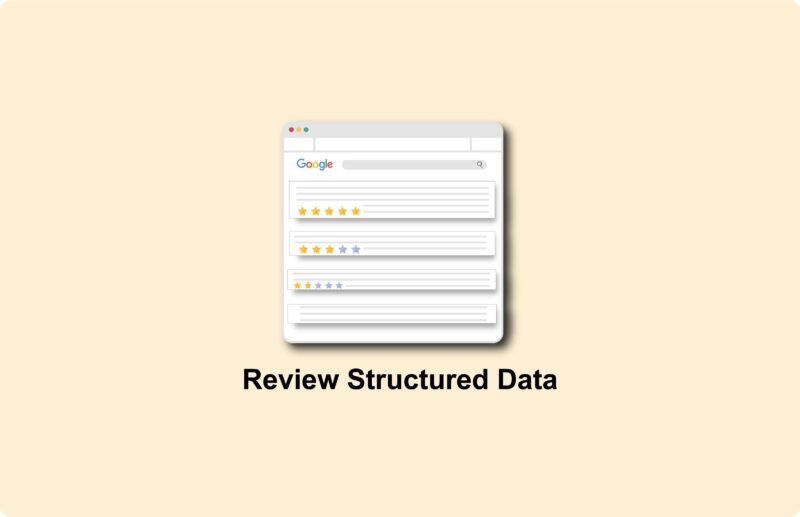My introduction to review structured data

In today’s digital world, reviews play a very important role in the credibility and visibility of online products and services. In this article, I take a detailed look at the importance of review structured data and how it can improve SEO and customer trust.
What is review structured data?
‘Review structured data is a type of markup used to display reviews of products or services in a standardized way on the Internet. It helps search engines display user reviews in a clear and understandable way.

Benefits of review structured data for SEO
The use of review structured data can significantly improve search results because reviews appear immediately in search engines. This is not only good for SEO, but also creates trust with potential customers thanks to clear and immediately visible customer reviews.
Review structured data in a nutshell
No time for a long article? No problem. Watch the video below for a summary of this article.
Key features of review structured data
Important features of review structured data are the name of the user, the score and the date of the review. It is also important to use the “reviewBody,” which contains the original text of the review.
The function of schema.org
Schema.org provides clear guidelines for marking reviews, such as “Review” and “AggregateRating. These instructions contribute to accurate and effective structuring of assessment data.
Preparations
Make sure you have access to the HTML code of the page where you want to apply the review structured data. Gather all data, such as the reviewer’s name, the rating and the review itself.
Overview of the steps
- Choose the format: decide whether you want to use JSON-LD, Microdata or RDFa.
- Collect the right information: collect all data for each review.
- Write the structured data code: use the Schema.org guidelines to write the review structured data code.
- Add the code to your website: add the code to the relevant page on your website.
- Test and verify the code: use the help of the Google Structured Data Testing Tool to verify that the structured data works as planned.
Follow the steps above to successfully implement review structured data on a website. This can greatly improve the visibility and credibility of your products or services.
Practical examples in different formats
- JSON-LD example:jsonCopy code
{ "@context": "http://schema.org", "@type": "Review", "author": { "@type": "Person", "name": "Jan Jansen" }, "reviewRating": { "@type": "Rating", "ratingValue": "5", "bestRating": "5" }, "reviewBody": "Dit is een uitstekend product, ik raad het ten zeerste aan!", "datePublished": "2024-01-23" } - Microdata example:htmlCopy code
<div itemscope itemtype="http://schema.org/Review"> <span itemprop="author" itemscope itemtype="http://schema.org/Person"> <span itemprop="name">Jan Jansen</span> </span> <div itemprop="reviewRating" itemscope itemtype="http://schema.org/Rating"> <meta itemprop="ratingValue" content="5" /> <meta itemprop="bestRating" content="5" /> </div> <span itemprop="reviewBody">Dit is een uitstekend product, ik raad het ten zeerste aan!</span> <meta itemprop="datePublished" content="2024-01-23" /> </div>
Checking and testing review structured data
Make sure the structured data is inserted correctly. By using validation tools such as the Google Structured Data Testing Tool or the Rich Results Test, you can verify this. In fact, these tools help detect and correct any errors in formatting.
Common errors and solutions
A common mistake when implementing review structured data is missing required fields or using incorrect markups. Make sure all required information is present and marked according to schema. org guidelines. Errors in structured data lead to poor display in search results or even ignored by search engines.
By following these steps carefully and using the right tools for control, you can implement review structured data correctly. This can significantly increase the credibility and visibility of your products or services and be an important link in your performance.
Examples of writing review structured data
I’d like to give you a few examples of how to use AggregateRating in structured data. To display a review snippet in Google search results, it is important to use schema markup. This is a form of microdata that helps search engines understand and process the content of a page. You use the AggregateRating scheme if you have a collection of reviews and want to show an overall rating in Google’s search results.
Here is an example of what this might look like in JSON-LD (a method for using Linked Data in JSON):
{
“@context”: “https://schema.org”,
“@type”: “Product”,
“name”: “SuperWidget 3000”,
“image”: “http://example.com/product.jpg”
“description”: “The latest SuperWidget 3000 is the best choice for your needs”,
“fire”: {
“@type”: “Brand”,
“name”: “WidgetCorp”
},
“aggregateRating”: {
“@type”: “AggregateRating”,
“ratingValue”: “4.4”,
“reviewCount”: “89”
},
“review”: [
{
“@type”: “Review”,
“author”: “Alice”,
“datePublished”: “2023-01-15”,
“description”: “Good product, but delivery was late.”,
“reviewRating”: {
“@type”: “Rating”,
“bestRating”: “5”,
“ratingValue”: “4”,
“worstRating”: “1”
}
},
// … other reviews …
]
}
Explanation of parts:
- @context: specifies that the data is based on the Schema.org standard.
- @type: Specifies the type of the item (in this case, a
product). - name, image, description, brand: basic information about the product.
- aggregateRating: an object representing the aggregate rating data.
- @type: indicates it is a
AggregateRating. - ratingValue: the average rating score.
- reviewCount: the total number of reviews included in the average score.
- @type: indicates it is a
- review: a list of individual review objects
- Each review item contains information about the author, publication date, description and rating.
By accurately integrating this structured data on your website, Google can understand the information and choose to display it in search results. This can lead to improved visibility and higher interaction rates. While structured data increases the likelihood of displaying extended snippets in search results, it is important to remember that Google ultimately determines whether and how reviews are displayed.
Writing a shorter version
If you want to write a shorter version of the structured data for an AggregateRating without individual reviews, you can omit the review section.
{
“@context”: “https://schema.org”,
“@type”: “Product”,
“name”: “SuperWidget 3000”,
“image”: “http://example.com/product.jpg”
“description”: “The latest SuperWidget 3000 is the best choice for your needs”,
“fire”: {
“@type”: “Brand”,
“name”: “WidgetCorp”
},
“aggregateRating”: {
“@type”: “AggregateRating”,
“ratingValue”: “4.4”,
“reviewCount”: “89”
}
}
In this version:
- The context (
@context) and type (@type) remain the same, indicating that the data is based on Schema.org and that the main type is anProduct. - name, image, description, and brand provide basic information about the product.
- aggregateRating is the most important part here and includes:
@type: indicates that it is an AggregateRating.ratingValue: displays the average rating score.reviewCount: shows the total number of reviews included in the average score.
This structured data summarizes the overall assessment of the product. It does not provide further details of the individual assessments. This can be an advantage on product summary pages or if you only want to show the overall rating without showing individual customer reviews.

Summary
In this short tutorial, I explained how to use structured data for AggregateRating.And I showed how to set up the overall rating of a product in JSON-LD format. By highlighting the average rating and the total number of reviews, you ensure a clearer presentation of product reviews. This can help improve search engine visibility without showing individual ratings. If you want to see a full overview of the options around Review structured data, click on this link from Google.






